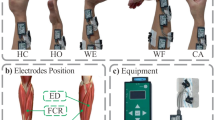Abstract
The successful decoding of kinematic variables from spike trains of motor cortical neurons is essential for cortical neural prosthesis. Spike trains from each single unit must be extracted from extracellular neural signals and, thus, spike detection and sorting procedure is indispensable but the detection and sorting may involve considerable error. Thus, a decoding algorithm should be robust with respect to spike train errors. Here, we show that spike train decoding algorithms employing nonlinear mapping, especially a support vector machine (SVM), may be more advantageous contrary to previous results which showed that an optimal linear filter is sufficient. The advantage became more conspicuous in the case of erroneous spike trains. Using the SVM, satisfactory training of the decoder could be achieved much more easily, compared to the case of using a multilayer perceptron, which has been employed in previous studies. Tests were performed on simulated spike trains from primary motor cortical neurons with a realistic distribution of preferred direction. The results suggest the possibility that a neuroprosthetic device with a low-quality spike sorting preprocessor can be achieved by adopting a spike train decoder that is robust to spike sorting errors.




Similar content being viewed by others
References
Amari S, Murata N, Muller KR, Finke M, Yang H (1996) Statistical theory of overtraining. Adv Neural Inf Proc Sys 8:176–182
Andersen RA, Musallam S, Pesaran B (2004) Selecting the signals for a brain–machine interface. Curr Opin Neurobiol 14:720–726
Ben-Shaul Y, Stark E, Asher I, Drori R, Nadasdy Z, Abeles M (2003) Dynamical organization of directional tuning in the primate premotor and primary motor cortex. J Neurophysiol 89:1136–1142
Donoghue JD (2002) Connecting cortex to machines: recent advances in brain interfaces. Nat Neurosci 5:1085–88
Georgopoulos AP, Schwartz AB, Kettner RE (1986) Neuronal population coding of movement direction. Science 233:1416–1419
Haykin S (1999) Neural networks: a comprehensive foundation. Prentice Hall, New Jersey
Hoegaerts L, Suykens JAK, Vandewalle J, De Moor B (2005) Subset based least squares subspace regression in RKHS. Neurocomputing 63:293–323
Kemere C, Shenoy KV, Meng TH (2004) Model-based neural decoding of reaching movements: a maximum likelihood approach. IEEE Trans Biomed Eng 51:925–932
Kim KH, Kim SJ (2003) Method for unsupervised classification of multiunit neural signal recording under low signal-to-noise ratio. IEEE Trans Biomed Eng 50:421–431
Moran DW, Schwartz AB (1999) Motor cortical representation of speed and direction during reaching. J Neurophysiol 82:2676–2692
Morren G, Wolf U, Lemmerling P, Wolf M, Choi JH, Gratton E, De Lathauwer L, Van Huffel S (2004) Detection of fast neuronal signals in the motor cortex from functional near infrared spectroscopy measurements using independent component analysis. Med Biol Eng Comput 42:92–99
Pardo M, Sberveglieri G (2004) Remarks on the use of multilayer perceptrons for the analysis of chemical sensor array data. IEEE Sens J 4: 355–363
Serruya M, Hatsopoulos N, Fellows M, Paninski L, Donoghue J (2003) Robustness of neuroprosthetic decoding algorithms. Biol Cybern 88:219–228
Shoham S, Nagarajan SS (2004) The theory of CNS recording in neurprosthetics theory and applications. World Scientific, New Jersey
Smola A, Schölkopf B (2004) A tutorial on support vector regression. Stat Comput 14:199–222
Vapnik VN (1999) An overview of statistical learning theory. IEEE Trans Neural Networks 10:988–999
Warland DK, Reinagel P, Meister M (1997) Decoding visual information from a population of retinal ganglion cells. J Neurophysiol, 78:2336–2350
Wessberg J, Nicolelis MAL (2004) Optimizing a linear algorithm for real-time robotic control using chronic cortical ensemble recordings in monkeys. J Cogn Neurosci 16:1022–1035
Won DS, Wolf PD (2004) A simulation study of information transmission by multi-unit microelectrode recordings. Network: Comput Neural Syst 15:29–44
Acknowledgment
This research was supported by Regional Research Center Program which was conducted by the Ministry of Commerce, Industry and Energy of the Korean Government, and ERC program of MOST/KOSEF (grant #R11-2000-075-01001-0).
Author information
Authors and Affiliations
Corresponding author
Rights and permissions
About this article
Cite this article
Kim, K.H., Kim, S.S. & Kim, S.J. Improvement of spike train decoder under spike detection and classification errors using support vector machine. Med Bio Eng Comput 44, 124–130 (2006). https://doi.org/10.1007/s11517-005-0009-x
Received:
Accepted:
Published:
Issue Date:
DOI: https://doi.org/10.1007/s11517-005-0009-x




